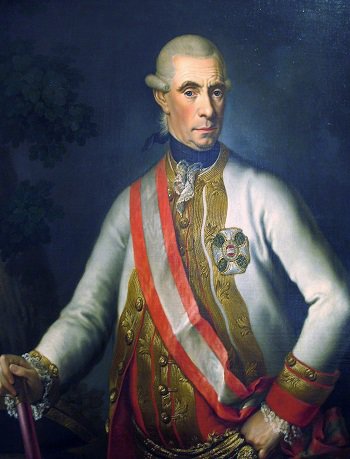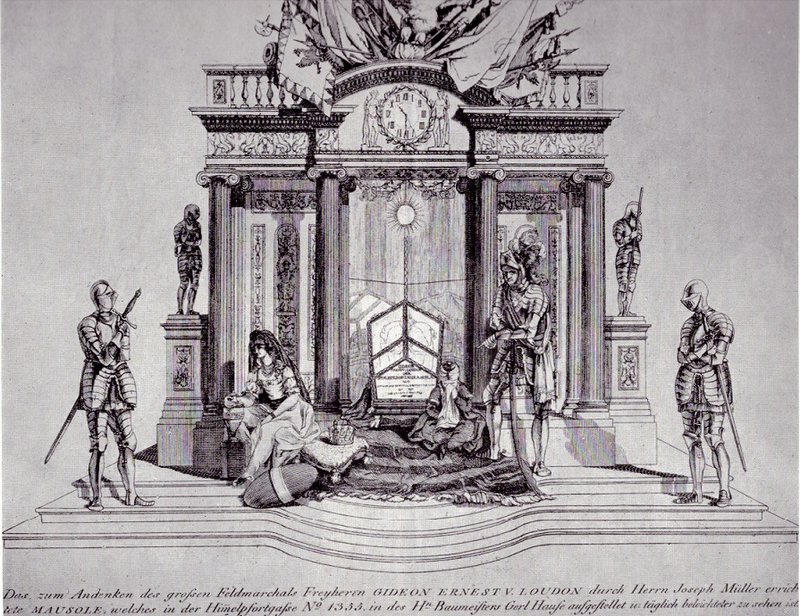Due to setbacks in the Austro-Turkish War of 1787-1791, the Habsburg court called back to active duty Gideon Ernst von Laudon (1717-1790), who had distinguished himself in previous Austrian campaigns, including the Seven Years’ War (1756-1763) and the War of the Bavarian Succssion (1778-1779). Laudon’s most decisive victory in the Austro-Turkish war was the siege and capture of Belgrade between 15 September and 8 October 1789. Laudon died on 14 July 1790.

Ernst Gideon, Freiherr von Laudon. Anonymous portrait in oils (Heeresgeschichtliches Museum, Vienna)
To commemorate Laudon’s death, Joseph Count Deym von Střítež – who following a duel more than a decade before had left Vienna but returned about 1780 now named Müller – constructed a memorial in his ‘Müllersche Kunstgallerie’ that over the years had become home to his collection of copies of ancient sculptures, mechanical toys and other curiousities. The memorial, which included newly-composed pieces of music performed by an unseen organ, was advertised in the Wiener Zeitung for 26 March 1791:
- Herr Müller, who has become
generally known through his art collection on the Stockameisenplat, No. 610,
fir floor, opened on the 23rd of March the Mausoleum erected by him,
which he has at great expense built in memory of the unforgettable and
world-famous Field Marshal Baron von Loudon, in the Himmelpfortgasse over
against the Mint, in the house of Herr Gerl, master-builder (No. 1355). Here
this remarkable monument may be seen in a setting especially designed for it on
the ground floor, splendidly illuminated from 8 o’clock in the morning until 10
o’clock at night; access to which is by the large door at the top of the third flight of the main staircase.
The distributed advertisements as well as the posters have given some
description of it, but since it is impossible to describe the whole with
sufficient vividness, the sight of it will not fail to surprise every one who
visits this Mausoleum and thereby renews the memory of this great and
meritorious man. Herr Müller has caused it to be engraved in copper, and
illuminated prints will shortly be available at the entrance. The seats are
arranged in the best possible way, and each person pays 1 fl. for a first place
and 30 kr. for a second; upon the stroke of each hour a Funeral Musique will be
heard, and will be different every week. This week the composition is by Herr
Kapellmeister Mozart.

'Das zum Andenken des grossen Feldmarchals Freyheren GIDEON ERNEST V. LOUDON durch Herrn Joseph Müller erreichtete MAUSOLE'. Engraving, Vienna 1791
The music composed by Mozart for Müller is supposed to be the Adagio and Allegro K594. If that is the case, then Müller may have had plans as early as the previous fall to construct the mausoleum since Mozart — if in fact he refers to K594 — wrote to his wife on 3 October 1790:
- I have now made up my mind to compose at one the Adagio for the clockmaker and then to slip a few ducats into the hand of my dear little wife. And this I have done; but as it is a kind of composition which I detest, I have unfortunately not been able to finish it. I compose a bit of it every day—but I have to break off now and then, as I get bored. And indeed I would give the whole thing up, if I had not such an important reason to go on with it. But I still hope that I shall be able to force myself gradually to finish it. If it were for a large instrument and the work would sound like an organ piece, then I might get some fun out of it. But, as it is, the works consist solely of little pipes, which sound too high-pitched and too childish for my taste.

W. A. Mozart, Verzeichnüß aller meiner Werke, f. 25r (British Library, London)